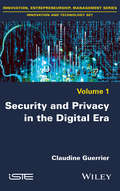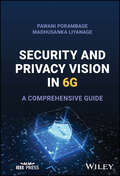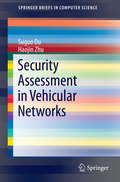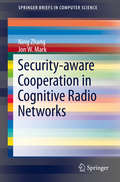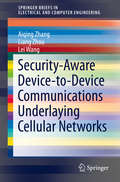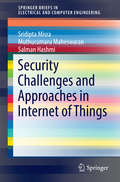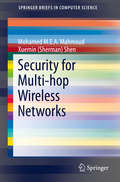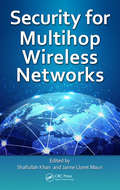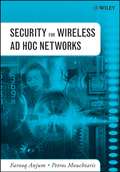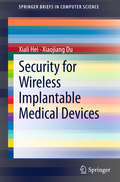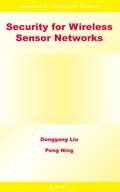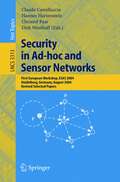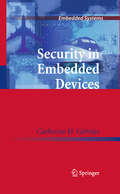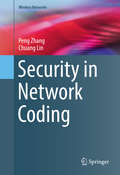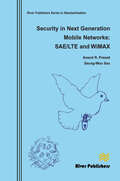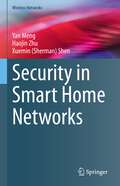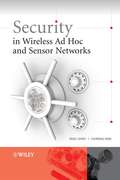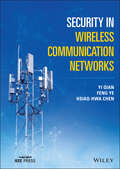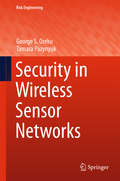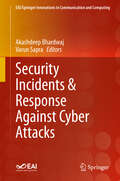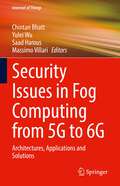- Table View
- List View
Security and Privacy in the Digital Era
by Claudine Guerrier"The state, that must eradicate all feelings of insecurity, even potential ones, has been caught in a spiral of exception, suspicion and oppression that may lead to a complete disappearance of liberties."—Mireille Delmas Marty, Libertés et sûreté dans un monde dangereux, 2010 This book will examine the security/freedom duo in space and time with regards to electronic communications and technologies used in social control. It will follow a diachronic path from the relative balance between philosophy and human rights, very dear to Western civilization (at the end of the 20th Century), to the current situation, where there seems to be less freedom in terms of security to the point that some scholars have wondered whether privacy should be redefined in this era. The actors involved (the Western states, digital firms, human rights organizations etc.) have seen their roles impact the legal and political science fields.
Security and Privacy in the Digital Era
by Claudine Guerrier"The state, that must eradicate all feelings of insecurity, even potential ones, has been caught in a spiral of exception, suspicion and oppression that may lead to a complete disappearance of liberties."—Mireille Delmas Marty, Libertés et sûreté dans un monde dangereux, 2010 This book will examine the security/freedom duo in space and time with regards to electronic communications and technologies used in social control. It will follow a diachronic path from the relative balance between philosophy and human rights, very dear to Western civilization (at the end of the 20th Century), to the current situation, where there seems to be less freedom in terms of security to the point that some scholars have wondered whether privacy should be redefined in this era. The actors involved (the Western states, digital firms, human rights organizations etc.) have seen their roles impact the legal and political science fields.
Security and Privacy Vision in 6G: A Comprehensive Guide
by Pawani Porambage Madhusanka LiyanageSECURITY AND PRIVACY VISION IN 6G Prepare for the future of mobile communication with this comprehensive study 6G is the next frontier in mobile communication, with development of 6G standards slated to begin as early as 2026. As telecommunications networks become faster and more intelligent, security and privacy concerns are critical. In an increasingly connected world, there is an urgent need for user data to be safeguarded and system security enhanced against a new generation of threats. Security and Privacy Vision in 6G provides a comprehensive survey of these threats and the emerging techniques for safeguarding against them. It includes mechanisms for prediction, detection, mitigation, and prevention, such that threats to privacy and security can be forestalled at any stage. Fully engaged with proposed 6G architectures, it is an essential resource for mobile communications professionals looking for a head start on the technology of the future. Security and Privacy Vision in 6G readers will also find: Detailed coverage of topics including edge intelligence and cloudification, industrial automation, collaborative robots, and more Treatment balancing the practical and the theoretical An editorial team with decades of international network technology experience in both industry and academia Security and Privacy Vision in 6G is a vital reference for network security professionals and for postgraduate and advanced undergraduate students in mobile communications and network security-related fields.
Security and Privacy Vision in 6G: A Comprehensive Guide
by Pawani Porambage Madhusanka LiyanageSECURITY AND PRIVACY VISION IN 6G Prepare for the future of mobile communication with this comprehensive study 6G is the next frontier in mobile communication, with development of 6G standards slated to begin as early as 2026. As telecommunications networks become faster and more intelligent, security and privacy concerns are critical. In an increasingly connected world, there is an urgent need for user data to be safeguarded and system security enhanced against a new generation of threats. Security and Privacy Vision in 6G provides a comprehensive survey of these threats and the emerging techniques for safeguarding against them. It includes mechanisms for prediction, detection, mitigation, and prevention, such that threats to privacy and security can be forestalled at any stage. Fully engaged with proposed 6G architectures, it is an essential resource for mobile communications professionals looking for a head start on the technology of the future. Security and Privacy Vision in 6G readers will also find: Detailed coverage of topics including edge intelligence and cloudification, industrial automation, collaborative robots, and more Treatment balancing the practical and the theoretical An editorial team with decades of international network technology experience in both industry and academia Security and Privacy Vision in 6G is a vital reference for network security professionals and for postgraduate and advanced undergraduate students in mobile communications and network security-related fields.
Security Assessment in Vehicular Networks (SpringerBriefs in Computer Science)
by Suguo Du Haojin ZhuThis book presents several novel approaches to model the interaction between the attacker and the defender and assess the security of Vehicular Ad Hoc Networks (VANETs). The first security assessment approach is based on the attack tree security assessment model, which leverages tree based methods to analyze the risk of the system and identify the possible attacking strategies the adversaries may launch. To further capture the interaction between the attacker and the defender, the authors propose to utilize the attack-defense tree model to express the potential countermeasures which could mitigate the system. By considering rational participants that aim to maximize their payoff function, the brief describes a game-theoretic analysis approach to investigate the possible strategies that the security administrator and the attacker could adopt. A phased attack-defense game allows the reader to model the interactions between the attacker and defender for VANET security assessment. The brief offers a variety of methods for assessing the security of wireless networks. Professionals and researchers working on the defense of VANETs will find this material valuable.
Security-aware Cooperation in Cognitive Radio Networks (SpringerBriefs in Computer Science)
by Ning Zhang Jon W. MarkThis brief investigates spectrum efficient and energy efficient strategies, known as cognitive radio networks (CRNs), to ensure secure cooperation between licensed and unlicensed users. The authors address issues of spectrum scarcity, spectrum sensing, transmission performance, trust-aware cooperation, and secure communications. Two security-aware cooperation based spectrum access schemes are presented. The first is a trust-aware cooperative framework for CRNs to improve the throughput or energy efficiency of licensed users and offer transmission opportunities to unlicensed users, taking into consideration the trustworthiness of unlicensed users. The second scheme is a cooperative framework to enhance secure communications of licensed users. An introduction to CRNs and literature survey enhance the discussion while numerical results are provided to demonstrate the viability of the proposed schemes. The brief is designed for researchers and professionals working with cognitive radio networks or interested in cooperation based access. Advanced-level students studying computer communication networks and communications engineering will also find this brief useful.
Security-Aware Device-to-Device Communications Underlaying Cellular Networks (SpringerBriefs in Electrical and Computer Engineering)
by Aiqing Zhang Liang Zhou Lei WangThe objective of this SpringerBrief is to present security architectures and incentive mechanisms to realize system availability for D2D communications. D2D communications enable devices to communicate directly, improving resource utilization, enhancing user’s throughput, extending battery lifetime, etc. However, due to the open nature of D2D communications, there are two substantial technical challenges when applied to large-scale applications, that is, security and availability which is demonstrated in this book.This SpringerBrief proposes a secure data sharing protocol, which merges the advantages of public key cryptography and symmetric encryption, to achieve data security in D2D communications. Furthermore, a joint framework involving both the physical and application layer security technologies is proposed for multimedia service over D2D communications thus the scalable security service can be achieved without changing the current communication framework. Additionally, as the system availability largely depends on the cooperation degree of the users, a graph-theory based cooperative content dissemination scheme is proposed to achieve maximal Quality of Experience (QoE) with fairness and efficiency.This SpringerBrief will be a valuable resource for advanced-level students and researchers who want to learn more about cellular networks.
Security Challenges and Approaches in Internet of Things (SpringerBriefs in Electrical and Computer Engineering)
by Sridipta Misra Muthucumaru Maheswaran Salman HashmiThis book provides a comprehensive survey of the security and privacy research advancements in Internet of Things (IoT). The book lays the context for the discussion by introducing a system model for IoT. Since IoT is very varied and has been introduced in many different contexts, the system model introduced plays a crucial role in integrating the concepts into a coherent framework. After the system model, the book introduces the vulnerable features of the IoT. By providing a comprehensive discussion of the vulnerable features, the book highlights the problem areas of IoT that should be studied concerning security and privacy. Using the vulnerable features as a motivation, the book presents a vast survey of existing security and privacy approaches for IoT. The survey is a good way for the reader to pick up interesting directions of research that have already been explored and also hints at directions that could take additional investigation. Finally, the book presents four case studies that provide a detailed view of how some of the security and privacy concerns are addressed in specific problem areas.
Security for Multi-hop Wireless Networks (SpringerBriefs in Computer Science)
by Mohamed M. Mahmoud Xuemin (Sherman) ShenThis Springer Brief discusses efficient security protocols and schemes for multi-hop wireless networks. It presents an overview of security requirements for these networks, explores challenges in securing networks and presents system models. The authors introduce mechanisms to reduce the overhead and identify malicious nodes that drop packets intentionally. Also included is a new, efficient cooperation incentive scheme to stimulate the selfish nodes to relay information packets and enforce fairness. Many examples are provided, along with predictions for future directions of the field. Security for Multi-hop Wireless Networks demonstrates recent research that enhances the efficiency and safety of these key networks. Concise and practical, it is a useful tool for researchers and professionals working in network security. It is also a valuable resource for advanced-level students interested in wireless communications and networking.
Security for Multihop Wireless Networks
Security for Multihop Wireless Networks provides broad coverage of the security issues facing multihop wireless networks. Presenting the work of a different group of expert contributors in each chapter, it explores security in mobile ad hoc networks, wireless sensor networks, wireless mesh networks, and personal area networks.Detailing technologies
Security for Wireless Ad Hoc Networks
by Farooq Anjum Petros MouchtarisThis book addresses the problems and brings solutions to the security issues of ad-hoc networks. Topics included are threat attacks and vulnerabilities, basic cryptography mechanisms, authentication, secure routing, firewalls, security policy management, and future developments. An Instructor Support FTP site is available from the Wiley editorial board.
Security for Wireless Implantable Medical Devices (SpringerBriefs in Computer Science)
by Xiali Hei Xiaojiang DuIn the treatment of chronic diseases, wireless Implantable Medical Devices (IMDs) are commonly used to communicate with an outside programmer (reader). Such communication raises serious security concerns, such as the ability for hackers to gain access to a patient’s medical records. This brief provides an overview of such attacks and the new security challenges, defenses, design issues, modeling and performance evaluation in wireless IMDs. While studying the vulnerabilities of IMDs and corresponding security defenses, the reader will also learn the methodologies and tools for designing security schemes, modeling, security analysis, and performance evaluation, thus keeping pace with quickly-evolving wireless security research.
Security for Wireless Sensor Networks (Advances in Information Security #28)
by Donggang Liu Peng NingThis book discusses fundamental security issues in wireless sensor networks, techniques for the protection of such networks, as well as results from recent studies in wireless sensor network security. It contains example applications for target tracking, scientific exploration and data acquisition in hazardous environments, and includes a fairly new study on capabilities of mu-TESLA, a broadcast authentication technique for wireless sensor networks. The book assists both professionals and students to understand background knowledge in wireless sensor network security and prepare them for producing research in this domain.
Security in Ad-hoc and Sensor Networks: First European Workshop, ESAS 2004, Heidelberg, Germany, August 6, 2004, Revised Selected Papers (Lecture Notes in Computer Science #3313)
by Claude Castelluccia Hannes Hartenstein Christof Paar Dirk WesthoffAd hoc and sensor networks are making their way from research to real-world deployments. Body and personal-area networks, intelligent homes, environmental monitoring or inter-vehicle communications: there is almost nothing left that is not going to be smart and networked. While a great amount of research has been devoted to the pure networking aspects, ad hoc and sensor networks will not be successfully deployed if security, dependability, and privacy issues are not addressed adequately. As the first book devoted to the topic, this volume constitutes the thoroughly refereed post-proceedings of the First European Workshop on Security in Ad-hoc and Sensor Networks, ESAS, 2004, held in Heidelberg, Germany in August 2004. The 17 revised full papers were carefully reviewed and selected from 55 submissions. Among the key topics addressed are key distribution and management, authentication, energy-aware cryptographic primitives, anonymity and pseudonymity, secure diffusion, secure peer-to-peer overlays, and RFIDs.
Security in Embedded Devices (Embedded Systems)
by Catherine H. GebotysAlthough security is prevalent in PCs, wireless communications and other systems today, it is expected to become increasingly important and widespread in many embedded devices. For some time, typical embedded system designers have been dealing with tremendous challenges in performance, power, price and reliability. However now they must additionally deal with definition of security requirements, security design and implementation. Given the limited number of security engineers in the market, large background of cryptography with which these standards are based upon, and difficulty of ensuring the implementation will also be secure from attacks, security design remains a challenge. This book provides the foundations for understanding embedded security design, outlining various aspects of security in devices ranging from typical wireless devices such as PDAs through to contactless smartcards to satellites.
Security in Network Coding (Wireless Networks)
by Peng Zhang Chuang LinThis book covers a series of security and privacy issues in network coding, and introduces three concrete mechanisms to address them. These mechanisms leverage traditional cryptographic primitives and anonymous protocols, and are redesigned to fit into the new framework of network coding. These three mechanisms are MacSig, a new message authentication method for network-coded systems; P-Coding, a new encryption scheme to secure network-coding-based transmissions; and ANOC, a new anonymous routing protocol that seamlessly integrates anonymous routing with network coding. Along with these three mechanisms, the authors provide a review of network coding's benefits, applications, and security problems. Also included is a detailed overview of security issues in the field, with an explanation of how the security issues differ from those in traditional settings. While network coding can help improve network performance, the adoption of network coding can be greatly limited unless security and privacy threats are addressed. Designed for researchers and professionals, Security in Network Coding explores major challenges in network coding and offers practical solutions. Advanced-level students studying networking or system security will also find the content valuable.
Security in Next Generation Mobile Networks: SAE/LTE and Wimax
by Anand R. Prasad Seung-Woo SeoStarting from voice services with simple terminals, today a mobile device is nothing sort of a small PC in the form of smart-phones. The result has been a huge increase in data-services giving mobile communication access to critical aspects of human society / life. This has led to standardization of SAE/LTE (System Architecture Evolution / Long Term Evolution) by 3GPP and IEEE 802.16e / WiMAX. Together with penetration of mobile communications and new standardization come new security issues and thus the need for new security solutions. This book provides a fresh look at those security aspects, with main focus on the latest security developments of 3GPP SAE/LTE and WiMAX. SAE/LTE is also known as Evolved Packet System (EPS).The intended audience for this book is mobile network and device architects, designers, researchers and students. The goal of the authors, who have a combined experience of more than 25 years in mobile security standardization, architecture, research, and education, is to provide the book?s readers with a fresh and up-to-date look at the architecture and challenges of EPS and WiMAX security.
Security in Next Generation Mobile Networks: SAE/LTE and Wimax (River Publishers Series In Standardisation Ser.)
by Anand R. Prasad Seung-Woo SeoStarting from voice services with simple terminals, today a mobile device is nothing sort of a small PC in the form of smart-phones. The result has been a huge increase in data-services giving mobile communication access to critical aspects of human society / life. This has led to standardization of SAE/LTE (System Architecture Evolution / Long Term Evolution) by 3GPP and IEEE 802.16e / WiMAX. Together with penetration of mobile communications and new standardization come new security issues and thus the need for new security solutions. This book provides a fresh look at those security aspects, with main focus on the latest security developments of 3GPP SAE/LTE and WiMAX. SAE/LTE is also known as Evolved Packet System (EPS).The intended audience for this book is mobile network and device architects, designers, researchers and students. The goal of the authors, who have a combined experience of more than 25 years in mobile security standardization, architecture, research, and education, is to provide the book?s readers with a fresh and up-to-date look at the architecture and challenges of EPS and WiMAX security.
Security in Smart Home Networks (Wireless Networks)
by Yan Meng Haojin Zhu Xuemin (Sherman) ShenThis book presents the security and privacy challenges of the smart home following the logic of “terminal device – voice interface – application platform”. For each component, the authors provide answers to the three questions: 1) In the terminal device layer, how to conduct cross-layer privacy breach analysis and provide effective countermeasures; 2) In the voice interface layer, how to design effective and lightweight schemes to defend against voice spoofing; 3) In the application layer, how to design an effective anomaly detection system without breaching the application platform. The authors conduct a thorough analysis of the security threats and challenges in each component of the smart home, review the existing state-of-the-art solutions proposed by other researchers, and elaborate on proposed countermeasures. This book aims to provide both security threats analysis and state-of-the-art countermeasures for the smart home network.
Security in Wireless Ad Hoc and Sensor Networks
by Erdal Cayirci Chunming RongThis book provides an in-depth guide to security in wireless ad hoc and sensor networks Security in Wireless Ad Hoc and Sensor Networks introduces the reader to the fundamentals and key issues related to wireless ad hoc networking, with an emphasis on security. It discusses the security attacks and counter measures in wireless ad hoc, sensor and mesh networks, and briefly presents the standards on related topics. The authors offer a clear exposition of various challenges and solutions in this field including bootstrapping, key distribution and exchange, authentication issues, privacy, anonymity and tamper resilience. Key Features: Introduces the fundamentals and key issues of the new technologies followed by comprehensive presentation on security attacks and counter measures Covers Denial of Service (DoS) attacks, hardware aspects of secure wireless ad hoc and sensor networks and secure routing Contains information on cryptographic primitives and electronic warfare Includes problems at the end of each chapter to enhance learning. This book is well suited for graduate students in computer, electrical and communications engineering and computer science departments, researchers in academia and industry, as well as C4I engineers and officers in the military. Wireless network designers for internet service providers and mobile communications operators will also find this book very useful.
Security in Wireless Communication Networks (IEEE Press)
by Yi Qian Feng Ye Hsiao-Hwa ChenReceive comprehensive instruction on the fundamentals of wireless security from three leading international voices in the field Security in Wireless Communication Networks delivers a thorough grounding in wireless communication security. The distinguished authors pay particular attention to wireless specific issues, like authentication protocols for various wireless communication networks, encryption algorithms and integrity schemes on radio channels, lessons learned from designing secure wireless systems and standardization for security in wireless systems. The book addresses how engineers, administrators, and others involved in the design and maintenance of wireless networks can achieve security while retaining the broadcast nature of the system, with all of its inherent harshness and interference. Readers will learn: A comprehensive introduction to the background of wireless communication network security, including a broad overview of wireless communication networks, security services, the mathematics crucial to the subject, and cryptographic techniques An exploration of wireless local area network security, including Bluetooth security, Wi-Fi security, and body area network security An examination of wide area wireless network security, including treatments of 2G, 3G, and 4G Discussions of future development in wireless security, including 5G, and vehicular ad-hoc network security Perfect for undergraduate and graduate students in programs related to wireless communication, Security in Wireless Communication Networks will also earn a place in the libraries of professors, researchers, scientists, engineers, industry managers, consultants, and members of government security agencies who seek to improve their understanding of wireless security protocols and practices.
Security in Wireless Communication Networks (IEEE Press)
by Yi Qian Feng Ye Hsiao-Hwa ChenReceive comprehensive instruction on the fundamentals of wireless security from three leading international voices in the field Security in Wireless Communication Networks delivers a thorough grounding in wireless communication security. The distinguished authors pay particular attention to wireless specific issues, like authentication protocols for various wireless communication networks, encryption algorithms and integrity schemes on radio channels, lessons learned from designing secure wireless systems and standardization for security in wireless systems. The book addresses how engineers, administrators, and others involved in the design and maintenance of wireless networks can achieve security while retaining the broadcast nature of the system, with all of its inherent harshness and interference. Readers will learn: A comprehensive introduction to the background of wireless communication network security, including a broad overview of wireless communication networks, security services, the mathematics crucial to the subject, and cryptographic techniques An exploration of wireless local area network security, including Bluetooth security, Wi-Fi security, and body area network security An examination of wide area wireless network security, including treatments of 2G, 3G, and 4G Discussions of future development in wireless security, including 5G, and vehicular ad-hoc network security Perfect for undergraduate and graduate students in programs related to wireless communication, Security in Wireless Communication Networks will also earn a place in the libraries of professors, researchers, scientists, engineers, industry managers, consultants, and members of government security agencies who seek to improve their understanding of wireless security protocols and practices.
Security in Wireless Sensor Networks (Risk Engineering)
by George S. Oreku Tamara PazynyukThis monograph covers different aspects of sensor network security including new emerging technologies. The authors present a mathematical approach to the topic and give numerous practical examples as well as case studies to illustrate the theory. The target audience primarily comprises experts and practitioners in the field of sensor network security, but the book may also be beneficial for researchers in academia as well as for graduate students.
Security Incidents & Response Against Cyber Attacks (EAI/Springer Innovations in Communication and Computing)
by Akashdeep Bhardwaj Varun SapraThis book provides use case scenarios of machine learning, artificial intelligence, and real-time domains to supplement cyber security operations and proactively predict attacks and preempt cyber incidents. The authors discuss cybersecurity incident planning, starting from a draft response plan, to assigning responsibilities, to use of external experts, to equipping organization teams to address incidents, to preparing communication strategy and cyber insurance. They also discuss classifications and methods to detect cybersecurity incidents, how to organize the incident response team, how to conduct situational awareness, how to contain and eradicate incidents, and how to cleanup and recover. The book shares real-world experiences and knowledge from authors from academia and industry.
Security Issues in Fog Computing from 5G to 6G: Architectures, Applications and Solutions (Internet of Things)
by Chintan Bhatt Yulei Wu Saad Harous Massimo VillariThe book provides an examination of how fog security is changing the information technology industry and will continue to in the next decade. The authors first discuss how fog enables key applications in wireless 5G, the Internet of Things, and big data. The book then presents an overview of fog/edge computing, focusing on its relationship with cloud technology, Internet of Things and the future with the use of secure 5G/6G communication. The book also presents a comprehensive overview of liabilities in fog/edge computing within multi-level architectures and the intelligent management. The last part of the book reviews applications of fog/edge computing in smart cities, including in Industrial IoT, edge-based augmented reality, data streaming, and blockchain-based.
